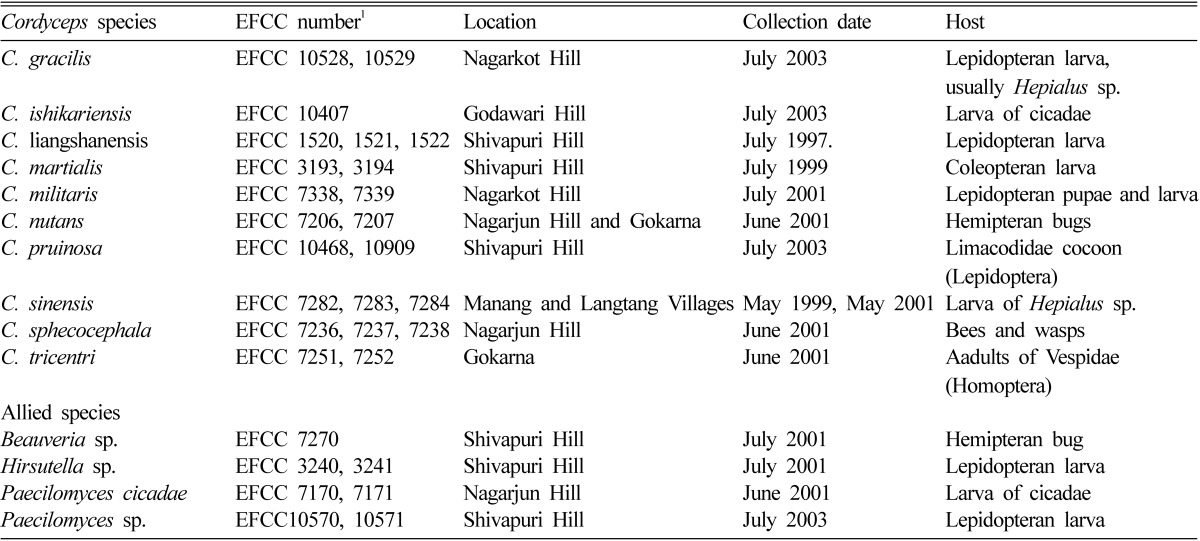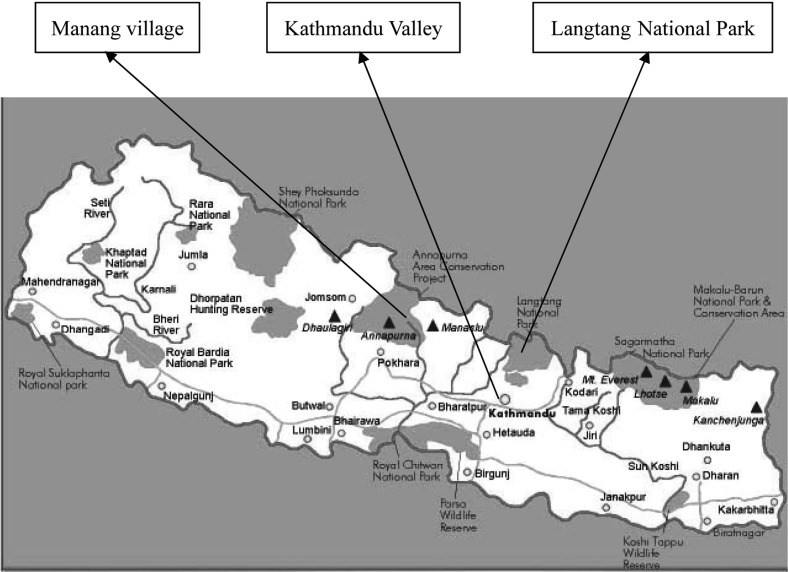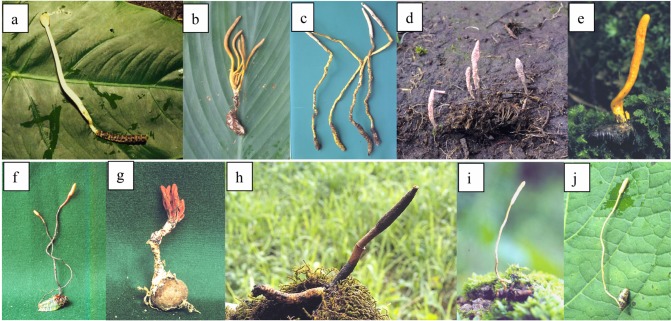Abstract
The present study was carried out to explore the Cordyceps species and other entomopathogenic fungal flora around Kathmandu Valley and a few high altitude locations of Nepal. In this paper, we report eight Cordyceps species as new to Nepal: C. gracilis, C. ishikariensis, C. liangshanensis, C. martialis, C. militaris, C. pruinosa, C. sphecocephala and C. tricentri. We also mention a few allied genera such as Beauveria, Hirsutella and Paecilomyces from Nepal. Further collections from different ecological regions of Nepal will show the richness of entomopathogenic fungal floral diversity of Nepal.
Keywords: Cordyceps, Entomopathogenic fungi, Kathmandu valley, Langtang area, Manang village
Cordyceps species have been reported from many parts of the world. The genus Cordyceps belongs to the family Clavicipitaceae in the order Hypocreales of Ascomycota. Cordyceps species mostly infect different stages of their host insects from larva to adult, kill them and eventually grow out of dead bodies of insects, except for a few species which grow on hypogeal Elaphomyces species. Very few Cordyceps species, including C. sinensis, have been reported from Nepal. However, scientific research on these species has been lacking although knowledge on their medicinal properties such as tonic and aphrodisiac values are common in the Nepalese society. Scientific studies on Cordyceps species started about 300 years ago, when Cordyceps militaris was described under the generic name, Clavaria, due to its Clavaria-like stromata (Linnaeus, 1753). Linnaeus followed the same generic name Clavaria and mentioned few Cordyceps species in his great work Species Plantarum (Linnaeus, 1753). Since then, it has attracted attention of great mycologists such as Persoon (1799), Fries (1823), Link (1833), Berkeley (1843), Tulasne Brothers (1865), Saccardo (1883) and Massee (1895) and was described under different generic names. Old literature proposed different generic names for Cordyceps such as Clavaria, Sphaeria and Torrubia, before Link (1833) finally erected Cordyceps as a new generic name. During last hundred years or more, regional exploration of Cordyceps species continued in many parts of the world such as Australia (Olliff, 1895; Willis, 1959), North America (Seaver, 1911; Mains, 1958), New Zealand (Dingley, 1953), Ceylon (present day Sri Lanka) (Petch, 1924), Great Britain (Petch, 1932, 1948), Japan (Kobayasi, 1939a, b, 1941; Kobayasi and Shimizu, 1983), Congo (Moureau, 1962), Norway (Eckblad, 1967), Ghana (Samson et al., 1982), Taiwan (Tzean et al., 1997), Amazonia (Evans and Samson, 1982, 1984; Samson and Evans, 1985), Thailand (Hywel-Jones 1994, 1995a, b, c, 1996; Hywel-Jones and Sivichai, 1995), Korea (Sung, 1996), China (Zang and Kinjo, 1998), and Mexico (Guzman et al., 2001). Apart from the work of Petch, very little work has been carried out on Cordyceps in South Asian region. To date, a few species of Cordyceps have been reported from Nepal. C. sinensis is one of them, which has been reported from high altitude areas (Balfour-Browne, 1955; Kobayasi, 1981; Adhikari and Durrieu, 1996). This species is the most popular species in Nepal due to its high medicinal values, thus regarded as a natural gift for humans as in other East Asian countries. Another Cordyceps species, C. nutans has been reported in Manang Region (Shrestha, 1985). The third Cordyceps species, C. nepalensis was reported as a new Cordyceps species from Mt. Kangchenjunga of Nepal (Zang and Kinjo, 1998). Recently, a glimpse of Cordyceps diversity of Nepal was presented (Shrestha and Sung, 2005).
A Few Cordyceps exploration trips were carried out in Nepal during last several years to explore entomopathogenic fungal diversity of Nepal. Detailed taxonomic studies of Cordyceps species collected from Korea and other parts of the world, including Nepal, are undergoing at Entomopathogenic Fungal Culture Collection (EFCC), Kangwon National University, Korea (Shrestha et al., 2004; Sung et al., 2005). This paper intends to provide information on Cordyceps species collected from Nepal during last few years in order to highlight the entomopathogenic fungal diversity of Nepal (Table 1).
Table 1.
Cordyceps species collected from Nepal

1EFCC; Entomopathogenic Fungal Culture Collection, Kangwon National University, Chuncheon 200-701, Korea.
Collection trips were made around Kathmandu Valley (Fig. 1) from 1997 to 2001 and in 2003. One trip was made to Langtang National Park in 2001, from where the specimens of C. sinensis were purchased from local collectors. C. sinensis specimens collected from local people of Manang Area were also observed. Specimens were airdried and have been preserved in Entomopathogenic Fungal Culture Collection (EFCC), Kangwon National University, Chuncheon, Korea. Morphological characters of Cordyceps species given by Mains (1958), Kobayasi (1941, 1982), Kobayasi and Shimizu (1983), Shimizu (1997), Tzean et al. (1997) and Zang and Kinjo (1998) were referred to for the identification of Cordyceps species (Fig. 2).
Fig. 1.
Geographical map of Nepal.
Fig. 2.
Cordyceps species collected from Nepal. a, C. gracilis; b, C. ishikariensis; c, C. liangshanensis; d, C. martialis; e, C. militaris; f, C. nutans; g, C. pruinosa; h, C. sinensis; i, C. sphecocephala; j, C. tricentri.
Cordyceps gracilis Durieu & Montagne
Stroma consists of a stout cylindrical stipe, with a white to light brown, and ovoid to subglobose, brown-colored head. Stipe ranges from 30~49 mm in length and 1~2 mm in diameter. Head is 3~6 mm long and 3~4 mm wide. Stromata are produced in solitary per host, usually from head or thorax region. Both stalk and head are smooth in surface. Head is dotted with ostioles of perithecia. Perithecia are completely immersed in head and range in size from 500~600 × 150~200 µm. Perithecia are ovoid with a slightly long neck. Size of ascus is 325~350 × 5 µm. Size of ascus cap is 6~6.5 × 4~4.5 µm.
Cordyceps ishikariensis Kobayasi & Shimizu
It produces five to six brown-yellow colored stromata per host. Stromata arise from the head region of the host. Stipe is 30~35 mm long, whereas head is 15~20 mm long. Stromata are 1.5~2 mm wide, stipe being more slender than head. Stipe is rough due to torn outer epidermal layer. Perithecia are semi-immersed and 500~570 × 240~300 µm in size. Perithecia are ovoid to broadly ovoid. Size of ascus is 250~360 × 4 µm. Size of ascus cap is 3~4 × 2 µm.
Cordyceps liangshanensis M. Zang, D. Liu & R. Hu
Stromata are light to dark brown and are produced in solitary. Stromata arise from the head region of the host. Surface of stipe is longitudinally striate. Stipe ranges from 40~60 mm in length and 1.5~2 mm in diameter. Head is about 15 mm long and slightly wider than stipe. Perithecia are semi-immersed and 400~450 × 200~250 µm in size. Perithecia are ovoid to oval in shape. Size of ascus is 175~210 × 6~7 µm. Size of ascus cap is 4~5 × 3 µm.
Cordyceps martialis Speg
It produces brownish orange stromata, one to a few per host. Stipe varies in length from 25 to 45 mm, while head ranges from 10 to 20 mm. Stipe and head are 0.5~1 and 1~2 mm wide, respectively. Surface of the head is rough due to presence of neck of immersed perithecia. Surface of stipe is sometimes covered by short spine-like structures. Upper parts of head are sometimes branched. Perithecia are ovoid or flask-shaped with long conical neck and almost immersed in head. They range in size from 500~530 × 150 µm. Size of ascus is 225~260 × 5~6 µm. Size of ascus cap is 6~7 × 4~5 µm.
Cordyceps militaris. (L. ex Fr.) Link
Stromata are usually orange, club or clavate shaped. Stipe and head are 25~40 mm and 20~30 mm long, respectively. Stipe is 1~1.5 mm wide, head being slightly broader than stipe. Stromata are usually solitary, but sometimes a few per host. Surface of head is rough due to apices of perithecia. Stipe is sometimes slightly twisted and the surface is irregularly furrowed. Perithecia are semi-immersed in head and are 650~770 × 300~500 µm in size. Perithecia are broadly ovoid in shape. Size of ascus is 350~450 × 3~4 µm. Size of ascus cap is 3~4 × 3~3.5 µm. Size of partspore is 3~3.5 × 1 µm.
Cordyceps nutans Patouillard
It produces black stipe with yellow to orange or red head. The uppermost part of stipe is usually similar to head in color. Stipe and head are 42~60 × 1 mm and 5~10 × 1~1.5 mm in size, respectively. The head is oval, obtuse or cylindrical and is erect. Surface of head is smooth and that of stipe is smooth, but longitudinally furrowed. Stipe is sometimes twisted. Stromata vary from solitary to a few per host. Perithecia are completely immersed and are obliquely vertical in head. They are 800~900 × 300 µm in size and elongated flask shaped. Size of ascus is 525~550 × 4~7 µm. Size of ascus cap is 10~12 × 6~8 µm. Size of part-spore is 7~8 × 1~1.4 µm.
Cordyceps pruinosa Petch
It produces red colored stromata, single or few per host. Stipe is 10~15 × 1 mm in size and head is 5~10 mm long and 1.5 mm wide. The head is narrow-clavate. Surface of head is rough due to ostioles of semi-immersed perithecia. Stipe has irregular but short furrows on its surface. Perithecia are semiimmersed in head and are 350~500 × 240~290 µm in size. Perithecia are ovoid, with ostiole sometimes directed to one side. Size of ascus is 185~200 × 2 µm. Size of ascus cap is 3 × 1.5~2 µm. Part-spores are joined at both ends in a thin thread-like structure.
Cordyceps sinensis. (Berk.) Sacc
Stromata are black with cylindrical stipe and slightly swollen head, usually with sterile apex. Stipe ranges from 40~45 mm in lengths and 1.5 mm wide. Head is slightly wider than stipe, usually 2 mm wide and 20~25 mm long. Perithecia are slightly projecting from the surface of the head. Surface of stipe is smooth with irregularly furrowed. Stipe is slightly twisted. Perithecia are 330~370 µm long and 170~270 µm wide. Perithecia are ovoid and have thick perithecial wall. Size of ascus is 200~210 × 7~8 µm.
Cordyceps sphecocephala (Berk.) Sacc
It produces pale-yellow to brownish-yellow slender stipe with ovoid to cylindrical yellow head. Stipe is 30~55 mm long and 1 mm wide. Head is 5~10 mm long and wider than stipe, about 1.5~2 mm wide. Each host produces single stroma. Stipe is smooth and longitudinally striate. Head is dotted with ostioles of perithecia on apex of ridges. Perithecia are immersed in head and are 620~780 × 200~230 µm in size. Perithecia are obliquely vertical in head, elongated flask-shaped or conoid in shape. Size of ascus is 350 × 6~7. Size of ascus cap is 8~9 × 5~6 µm. Size of partspore is 9~10.5 × 1~1.3 µm and is fusiform in shape with pointed ends.
Cordyceps tricentri Yasuda
Stromata are produced in solitary per host and are yellow in color. Stipe is 33~43 mm long and very slender, 0.25~0.3 mm wide. Head is ovoid, 5~6 mm long and 1~1.5 mm wide. Both stipe and head are smooth in surface. Perithecia are obliquely immersed in head and range from 550~650 × 110~120 µm in size. Perithecia are ovoid in shape. Ascus size is 300~320 × 5 µm. Ascus cap is 5~6 × 3~4 µm.
The present study has explored Cordyceps species in Nepal. Additionally, this study has also explored allied species of Cordyceps, such as Beauveria, Hirsutella, Paecilomyces, etc. Among Paecilomyces species, P. cicadae (Miquel) Samson was found growing on larva of cicadae in Nagarjun Area of Kathmandu valley.
Acknowledgement
The authors wish to acknowledge the financial support from Korea Science and Engineering Foundation (KOSEF) to Entomopathogenic Fungal Culture Collection (EFCC), Kangwon National University, Korea. Institute for Cordyceps Research of Kangwon National University is also thanked for providing research facilities to carry out this study. We also wishes acknowledge the permission for exploration of Cordyceps species in their respective areas from Department of Forests and Department of National Parks and Wildlife Conservation of the Government of Nepal.
References
- 1.Adhikari MK, Durrieu G. Ethnomycologie nepalaise. Bull Soc Mycol Fr. 1996;112:31–41. [Google Scholar]
- 2.Balfour-Browne FL. Some Himalayan fungi. Bull Brit Mus (Nat Hist) Ser Bot. 1955;1:189–218. [Google Scholar]
- 3.Berkeley MJ. On some entomogenous Sphaeriae. Hook Lond J Bot. 1843;2:205–211. [Google Scholar]
- 4.Dingley JM. The Hypocreales of New Zealand 5. The genera Cordyceps and Torrubiella. Trans Roy Soc New Zeal. 1953;81:329–343. [Google Scholar]
- 5.Eckblad FE. The genus Cordyceps in Norway. Nytt Mag Bot. 1967;14:68–76. [Google Scholar]
- 6.Evans HC, Samson RA. Cordyceps species and their anamorphs pathogenic on ants (Formicidae) in tropical forest ecosystems. I. The Cephalotes (Myrmicinae) complex. Trans Br Mycol Soc. 1982;79:431–453. [Google Scholar]
- 7.Evans HC, Samson RA. Cordyceps species and their anamorphs pathogenic on ants (Formicidae) in tropical forest ecosystems. II. The Camponotus (Formicinae) complex. Trans Br Mycol Soc. 1984;82:127–150. [Google Scholar]
- 8.Fries EM. Systema mycologicum. Lund. 1823;2:320–324. [Google Scholar]
- 9.Guzman G, Angelmoron M, Ramirez-Guillen F, Wolf JHD. Entomogenous Cordyceps and related genera from Mexico with discussions on their hosts and new records. Mycotaxon. 2001;78:115–125. [Google Scholar]
- 10.Hywel-Jones NL. Cordyceps khaoyaiensis and C. pseudomilitaris, two new pathogens of lepidopteran larvae from Thailand. Mycol Res. 1994;98:939–942. [Google Scholar]
- 11.Hywel-Jones NL. Cordyceps sphecocephala and a Hymenostilbe sp. infecting wasps and bees in Thailand. Mycol Res. 1995a;99:154–158. [Google Scholar]
- 12.Hywel-Jones NL. Notes on Cordyceps nutans and its anamorph, a pathogen of hemiptera bugs in Thailand. Mycol Res. 1995b;99:724–726. [Google Scholar]
- 13.Hywel-Jones NL. Cordyceps brunneapunctata sp. nov. infecting beetle larvae in Thailand. Mycol Res. 1995c;99:1195–1198. [Google Scholar]
- 14.Hywel-Jones NL. Cordyceps myrmecophila-like fungi infecting ants in the leaf litter of tropical forest in Thailand. Mycol Res. 1996;100:613–619. [Google Scholar]
- 15.Hywel-Jones NL, Sivichai S. Cordyceps cylindrica and its association with Numuraea atypicola in Thailand. Mycol Res. 1995;99:809–812. [Google Scholar]
- 16.Kobayasi Y. On the Genus Cordyceps and its allies on Cicadidae from Japan. Bull Biogeograph Soc Jap. 1939a;9:145–176. [Google Scholar]
- 17.Kobayasi Y. On the genus Cordyceps and its allies parasitic to Hymenoptera in Japan. Bull Biogeograph Soc Jap. 1939b;9:271–290. [Google Scholar]
- 18.Kobayasi Y. The Genus Cordyceps and its allies. Sci Rept Tokyo Bun Dai Sect B. 1941;5:53–260. [Google Scholar]
- 19.Kobayasi Y. Revision of the genus Cordyceps and its allies 2. Bull Natn Sci Mus Tokyo Ser 13. 1981;7(4):123–129. [Google Scholar]
- 20.Kobayasi Y. Keys to the taxa of the genera Cordyceps and Torrubiella. Trans Mycol Soc Jap. 1982;23:329–364. [Google Scholar]
- 21.Kobayasi Y, Shimizu D. Iconography of vegetable wasps and plant worms. Hoikusha Publishing Co. Ltd; 1983. [Google Scholar]
- 22.Link JHF. Handbuch zur Erkennung der Nutzbarsten und am Haufigsten Vorkommenden Gewachse. Berlin. 1833;3:347–348. [Google Scholar]
- 23.Linnaeus C. Species Plantarum. Ed I. 1753;2:1182. [Google Scholar]
- 24.Mains EB. North American Entomogenous species of Cordyceps. Mycologia. 1958;50:169–222. [Google Scholar]
- 25.Massee G. A revision of the genus Cordyceps. Ann Bot. 1895;9(33) [Google Scholar]
- 26.Moureau J. Description de trois autres Cordyceps du Congo. Lejeunia N S. 1962;14:1–23. [Google Scholar]
- 27.Olliff AS. Australian entomophytes or entomogenous fungi and some account of their insect hosts. New South Wales Agri Gaz. 1895;6:402–414. [Google Scholar]
- 28.Persoon DCH. Observationes. Mycologicae. 1799;2:65–67. [Google Scholar]
- 29.Petch T. Studies in entomogenous fungi IV. Some Ceylon Cordyceps. Trans Br Mycol Soc. 1924;10:28–45. [Google Scholar]
- 30.Petch T. A list of the entomogenous fungi of Great Britain. Trans Br Mycol Soc. 1932;17:170–178. [Google Scholar]
- 31.Petch T. A revised list of British entomogenous fungi. Trans Br Mycol Soc. 1948;31:286–304. [Google Scholar]
- 32.Saccardo PA. Cordyceps. Sylloge Fungorum. 1883;2:566–578. [Google Scholar]
- 33.Samson RA, Evans HC. New and rare entomogenous fungi from Amazonia (South America) Proc Ind Acad Sci Plant Sci. 1985;94:309–317. [Google Scholar]
- 34.Samson RA, Evans HC, Hoekstra ES. Notes on entomogenous fungi from Ghana VI. The genus Cordyceps. Proc K Nederl Akad Wetensch Ser C. 1982;85:589–605. [Google Scholar]
- 35.Seaver FJ. The Hypocreales of North America-IV. Mycologia. 1911;3:207–230. [Google Scholar]
- 36.Shrestha K. Cordyceps nutans Pat. from Lato Manang. J Nat Hist Mus. 1985;9:111–114. [Google Scholar]
- 37.Shrestha B, Han SK, Kim SY, Park YJ, Sung JM. Proceedings of 10th International Congress of Culture Collections: Innovative Roles of Biological Resource Centers. Tsukuba, Japan: JSCC and WFCC; 2004. Cordyceps diversity in Korea and its preservation in Entomopathogenic Fungal Culture Collection (EFCC) p. 556. (Abstract) [Google Scholar]
- 38.Shrestha B, Sung JM. Cordyceps diversity in Nepal. KSM Newsletter Korean Soc Mycol. 2005;17:105. (Abstract) [Google Scholar]
- 39.Shimizu D. Illustrated vegetable wasps and plant worms in colour. Tokyo: Ie-No-Hikari Association; 1997. [Google Scholar]
- 40.Sung JM. The insects-born fungus of Korea in color. Seoul: Kyohak Publishing Co. Ltd; 1996. [Google Scholar]
- 41.Sung JM, Shrestha B, Han SK, Kim SY, Park YJ, Lee WH, Jeong KY, Choi SK. Cordyceps diversity in Korea. Inoculum. 2005;56(4):3–4. [Google Scholar]
- 42.Tulasne LR, Tulanse C. Selecta Fungorum Carpologia (English translation) Vol. 3. Oxford: Clarendon Press; 1865. [Google Scholar]
- 43.Tzean SS, Hsieh LS, Wu WJ. Atlas of entomopathogenic fungi from Taiwan. Taiwan: Council of Agriculture; 1997. [Google Scholar]
- 44.Willis JH. Australian species of the fungal genus Cordyceps (Fr.) Link with critical notes on collection in Australian herbaria. Muelleria. 1959;1:68–89. [Google Scholar]
- 45.Zang M, Kinjo N. Notes on the Alpine Cordyceps of China and nearby nations. Mycotaxon. 1998;66:215–229. [Google Scholar]




